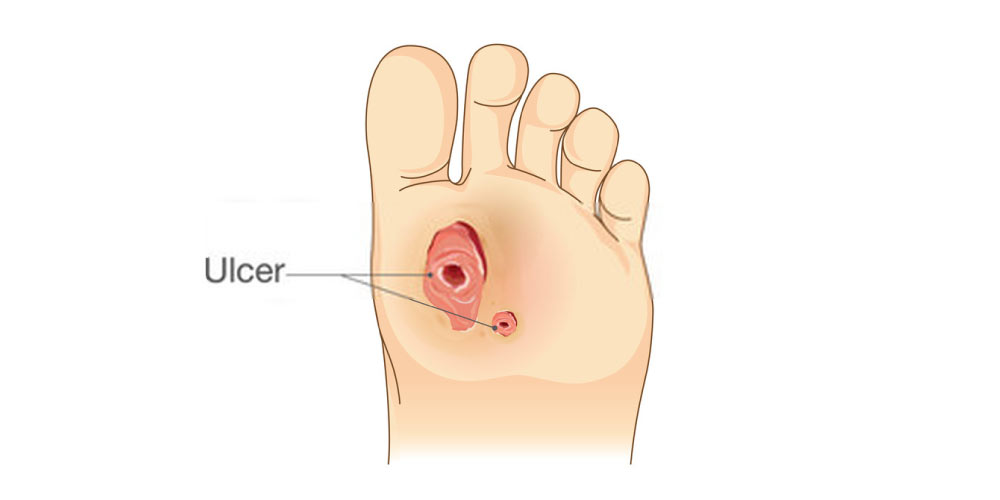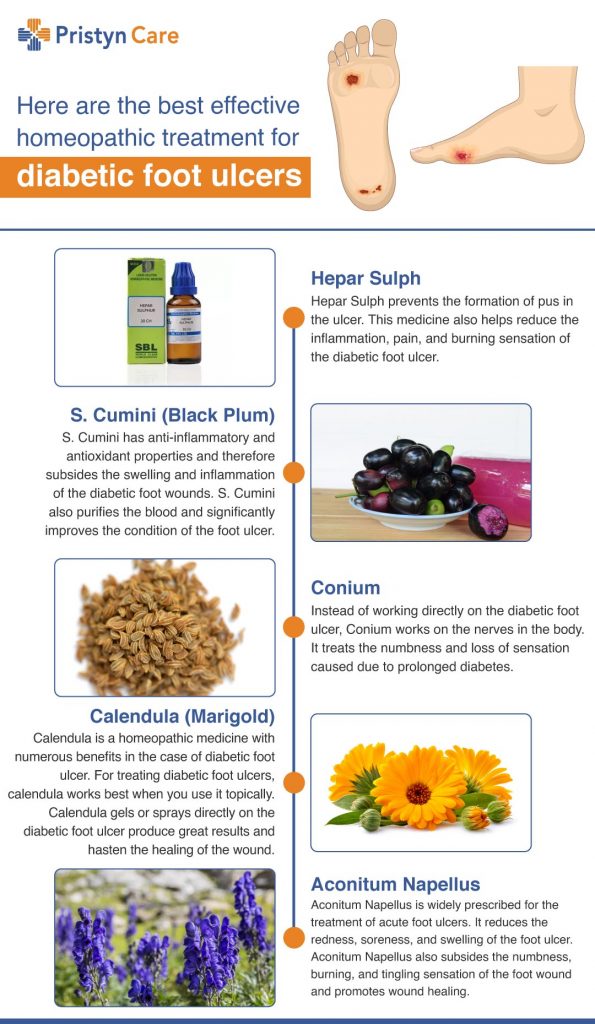
Foot ulcers in diabetic people are a common problematic sign of uncontrolled sugar levels. Such excessive blood sugar damages the vascular system, especially in the legs. This results in the formation of blisters on the foot (called the diabetic foot condition).
When the blister ruptures it oozes out malodorous discharge, which is highly prone to catching infections. Due to poor sensory stimulations in the foot, the person might not be able to evaluate the seriousness of the foot ulcer. Therefore, timely assessment and proper medications are a must for diabetic foot ulcers.

If you are looking out for the solution for the diabetic foot ulcers in homeopathy, you are at the right place.
Here, you will get to know about the effective homeopathic treatment for diabetic foot ulcers.
Table of Contents
Let’s get a detailed insight into the best homeopathic medicines for diabetic foot ulcers

Hepar Sulph
Hepar Sulph is one of the most common homeopathic medicines for treating diabetic foot ulcers. Hepar Sulph is made by combining the inner layer of oyster shells with flowers of sulfur and then burning them together.
The medicine prevents the formation of pus in the ulcer. If the pus has already formed, the medicine speeds up the pointing and discharge of the pus so that it can heal properly. This medicine also helps reduce the inflammation, pain, and burning sensation of the diabetic foot ulcer.
Cumini (Black Plum)
S.Cumini is a great homeopathic remedy for diabetes and diabetic foot ulcers. S.Cumini is derived from the Jambolan (Jamun) or Black Plum. Both the bark and the fruit of Jamun have excellent medicinal properties.
Cumini has anti-inflammatory and antioxidant properties and therefore subsides the swelling and inflammation of the diabetic foot wounds. S. Cumini also has anti-diabetic properties and thus keeps a check on the blood sugar levels, thereby preventing the worsening of the ulcer. In addition to these properties, S. Cumini also purifies the blood and significantly improves the condition of the foot ulcer.
Conium
Conium can be another useful homeopathic medicine for diabetes and diabetic foot ulcers. It is derived from a flowering plant called Hemlock.
Instead of working directly on the diabetic foot ulcer, it works on the nerves in the body. It treats the numbness and loss of sensation caused due to prolonged diabetes. Therefore, it helps to identify diabetic foot wounds in the initial stages only. However, you should not take this medicine without proper consultation with a homeopathic doctor. Otherwise, it can have severe side-effects that can act like a poison in excess amounts.
Calendula (Marigold)
Calendula is a homeopathic medicine with numerous benefits in the case of diabetic foot ulcers. This homeopathic remedy is derived from a plant commonly known as “Pot Marigold”.
For treating diabetic foot ulcers, calendula works best when you use it topically. Calendula gels or sprays directly on the diabetic foot ulcer produce great results and hasten the healing of the wound. Calendula extract has anti-inflammatory, antioxidant, and anti-microbial effects. Thus, homeopathic remedy prevents and treats infections in the diabetic foot ulcer. Calendula reduces the foul odor of the foot ulcer and facilitates the growth of new tissues, thereby promoting faster healing.
Aconitum Napellus
Aconitum Napellus is a medicine that is made from the Aconitum plant. The roots of this plant have medicinal properties. Aconitum Napellus is very often used in the management of diabetic foot ulcers.
Aconitum Napellus is widely prescribed for the treatment of acute foot ulcers. It reduces the redness, soreness, and swelling of the foot ulcer. Aconitum Napellus also subsides the numbness, burning, and tingling sensation of the foot wound and promotes wound healing.
Does homeopathic treatment work in severe cases of diabetic foot ulcers as well?
Homeopathic treatment work quite wonderfully in cases where the diabetic foot ulcer is diagnosed at an initial stage. In such cases, homeopathic medicines are quite effective in providing significant relief.
However, severe cases of diabetic foot ulcers require immediate medical attention and need to be treated as soon as possible. In such cases, delay in proper treatment can lead to serious complications.
It is a well-known fact that homeopathic medicines usually take longer to produce the desired results. Therefore, opting for homeopathic medicines in severe cases may not be a wise thing to do.
Thus, if diabetic foot ulcer in your case is severe, consult your doctor and discuss what treatment option you can choose for the best results.
Which treatment provides a permanent solution for severe foot ulcers?
Diabetic foot ulcers are very closely linked with a damaged vascular system and peripheral artery disease. Therefore, in the severe cases of diabetic foot ulcers, doctors usually recommend vascular surgeries.
Atherectomy is the vascular surgery for the treatment of diabetic foot ulcers. Atherectomy is performed to make the arteries wider so that proper supply of blood, oxygen, and nutrients can reach the foot. This, in turn, speeds up the healing process.
In atherectomy, the surgeon uses a rotating blade or laser energy to remove the layers of plaque, calcium and fat from the arteries. This makes the arteries wider and proper flow of blood can be maintained.
Sometimes, atherectomy is followed by another procedure called balloon angioplasty. In this procedure, the doctor inserts a stent inside the artery. The stent keeps the artery wide and ensures the proper flow of blood through the artery.
The concluding note
So, if your symptoms of diabetic foot ulcers are mild, you can follow homeopathic treatment. The key to healing early is to judiciously follow the dosage and duration of the medicines.
However, if you want to seek a specialist to discuss your condition of diabetic foot ulcers, we are there. You can easily reach out to us at Pristyn Care by booking your online appointment with us.
Also read:







